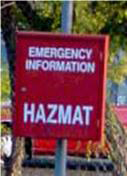Emergency planning
Queensland’s Work Health and Safety Regulation 2011 (section 43) stipulates that all workplaces must have a written emergency plan.
There are additional obligations if hazardous materials are used, handled or stored at a workplace.
- If the quantity of schedule 11 hazardous chemicals exceeds the manifest quantity for that hazardous chemical, the workplace must comply with section 361.
- For those workplaces deemed a major hazard facility, they must also comply with section 557.
If your workplace has obligations under section 361, you must give a copy of your emergency plan to us. You must also revise your plan if we provide you with any recommendations relating to the content or effectiveness of the emergency plan.
What is an emergency plan?
An emergency plan is a written document detailing how a workplace and its occupants deal with or manage an emergency.
An effective emergency plan consists of preparedness, response and recovery activities to mitigate identified risks at a workplace.
Risks may include:
- fire
- security
- medical
- electrical outage
- mechanical or process failure
- natural events such as storms or cyclones
- hazardous materials releases
It should also include roles and responsibilities of those who will carry out these activities.
The level of detail in the emergency plan will depend on the complexity of the activities at the workplace involved and what types of hazardous materials are stored or used at the site.
Developing your emergency plan
Developing your emergency plan
This information may help you develop your emergency plan.
- Emergency Planning Guidance
- Emergency Planning: A Guideline for Hazardous Industry
- An occupiers guide to emergency planning for ammonia-based refrigeration systems
Who can assist you with developing an emergency plan?
It's important to seek help if you are unsure about your workplace's emergency plan.
Private industry
There are consultants within private industry who specialise in writing emergency plans. Although we cannot recommend a particular consultant, it's important to engage with one who understands your business and requirements for an emergency plan that is appropriate for your workplace. You can find consultants using online search engines or industry associations.
Government agencies
Government agencies provide advice specifically on the requirements for the emergency plan.
Research & Scientific Branch (RSB)
Queensland Fire Department
Email: QFES.EMPlanning@fire.qld.gov.au
Phone: 07 3909 4318
Hazardous Chemicals Unit
Workplace, Health and Safety Queensland (WHSQ)
Email: hazchem@oir.qld.gov.au
Phone: 1300 362 128
The Hazardous Chemicals Unit can also provide advice about all other sections of the Work Health and Safety Act 2011.
Sending your emergency plan to us
Where to send your emergency plan?
Some workplaces are required to submit their emergency plans to us.
Emergency plans should be submitted in electronic form (preferably in PDF format) to QFES.EMPlanning@fire.qld.gov.au
Ensure the plan and the email includes:
- Contact name and position title.
- Contact phone/mobile numbers.
- Name of the workplace.
- Postal address.
- Street address of the main entrance with its location geo-coded in decimal degrees (4 or 5 decimal places) latitude and longitude.
What will you do when you receive an emergency plan?
- we will send a letter acknowledging receipt of your emergency plan and may forward a copy to the Queensland Police Service (QPS) if deemed necessary.
- we will classify your emergency plan. This will determine if your plan requires a review.
Plans that are reviewed
We may provide a written recommendation about the content or effectiveness of the emergency plan. A copy of the recommendation will also be provided to the Health & Safety Queensland Hazardous Chemicals Unit. Some organisations may be required to revise their plan in accordance with recommendations we make as outlined in the Work Health & Safety Regulation 2011. Those workplaces deemed Major Hazard Facilities (MHF) may have additional obligations.
Plans that are not reviewed
We will send a letter to the workplace advising a review of the emergency plan was not deemed necessary. The emergency plan will then be provided to our relevant local area office so it can be incorporated into their local preparedness activities. This may include developing a local area plan, visiting the workplace or arranging an exercise with the workplace.
Storing your emergency plan
As part of Work Health Safety Regulation 2011 Section 347 (3), an emergency plan or manifest must be kept in a place determined in agreement with the primary emergency service organisation. It must be available for inspection and readily accessible to the emergency service organisation.
We recommend the manifest be stored securely in a red weatherproof box (HAZMAT box). The HAZMAT box is typically 400 mm (H) x 300 mm (W) x 90 mm (D) and mounted securely. E.g. Attached to a steel post concreted into position. A 003 series lock should be installed to ensure security of the box. The HAZMAT box is typically labelled Emergency information and HAZMAT.

An example of a HAZMAT box
The HAZMAT box should be located inside the site as close as practical to the main entry. It should ideally be located near the outer warning sign and on the left side of the entrance so the fire officer can safely and easily access the box. If there are several entrances to the site that are used regularly, or a security post is used to control access to the site, then consideration should be given to placing a HAZMAT box at each entry, or within the security post.
If there are compelling reasons to consider storing the manifest in another location, consult with your local fire station about the best position for its location.
Further information
Useful resources
Government Agencies
Workplace, Health & Safety Queensland
Government Legislation
Queensland’s Work Health & Safety Regulation 2011
Emergency Planning Publications and Documents
Emergency Planning: Guidelines for Hazardous Industry
Safe Work Australia Emergency Plans Fact Sheet
AS 4083 Planning for emergencies: Health care facilities
AS 3745:2010 Planning for emergencies in facilities
AS 31000 Risk management - Principles and guidelines
AS 5050 Business continuity - Managing disruption-related risk
